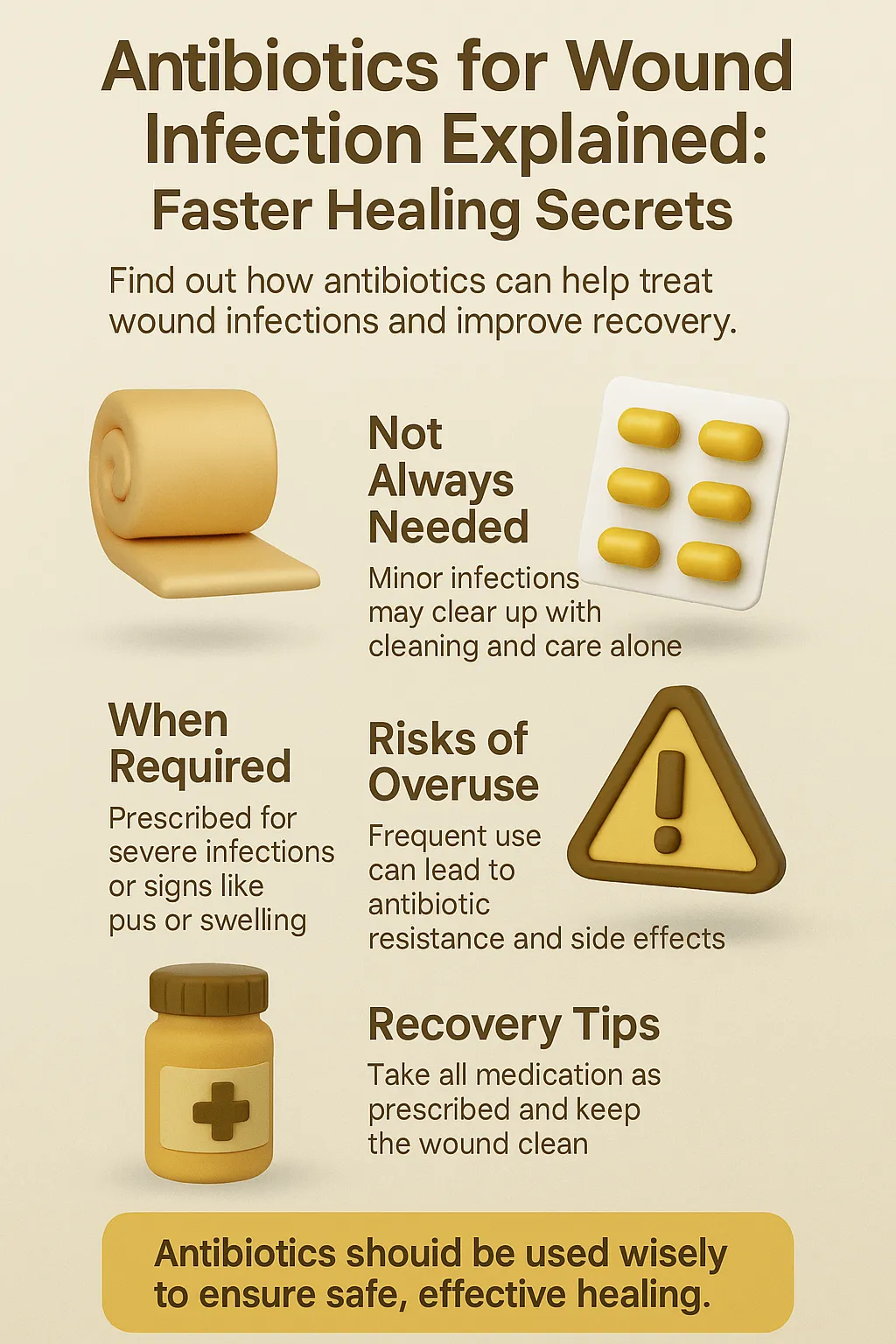If you’ve ever had a cut or wound that just wouldn’t heal, you’ve likely wondered: “Do antibiotics speed up recovery for wound infection?” The truth is more nuanced. Antibiotics can play a powerful role in recovery, but they aren’t always the first or best option.
From my experience with both surgical wounds and everyday injuries, I’ve seen antibiotics stop infections from spreading—but I’ve also seen cases where attentive wound care worked better than unnecessary prescriptions. The real secret lies in knowing when antibiotics are truly needed, and how good wound care can make healing faster and safer.
In this article, you’ll discover how antibiotics fit into wound healing, the risks of overuse, and proven strategies to promote faster recovery.
Top Takeaways
- Not every wound requires antibiotics. Many minor infections heal with cleaning and dressings.
- Antibiotics are best reserved for serious cases. They’re most effective for spreading or systemic infections.
- Wound care is essential. Prevention, cleaning, and monitoring often make the biggest difference.
When Antibiotics Help Wounds Heal Faster
Antibiotics are highly effective against infections—but not every wound benefits from them. For mild cases, cleaning, dressing changes, and rest are often enough. Doctors usually prescribe antibiotics when a wound shows signs of spreading infection, such as:
- Redness that extends outward
- Warmth and swelling
- Pus or drainage
- Fever or systemic symptoms
In these situations, antibiotics can prevent further complications and speed up healing. But taking them when not needed increases the risk of side effects and resistance.
Faster healing tips:
- Keep wounds clean and covered.
- Watch for warning signs of infection.
- Take the full course of antibiotics if prescribed.
- Support recovery with good rest, nutrition, and hydration.
Expert Insight
“In my practice, the fastest recoveries happen when antibiotics are used only when necessary—paired with consistent wound care and close monitoring. Antibiotics should enhance healing, not replace the fundamentals.”
Case Study & Real-World Examples
Small Cut, Faster Healing Without Antibiotics
Patient: Kitchen knife cut, mild redness.
Treatment: Cleaning + daily dressings.
Outcome: Healed within a week, no antibiotics needed.
Insight: Minor infections often resolve with attentive care.
Surgical Infection That Needed Antibiotics
Patient: Post-abdominal surgery with fever and swelling.
Treatment: Drainage + oral antibiotics.
Outcome: Symptoms improved within days.
Insight: Antibiotics were crucial for faster recovery.
Research Perspective
Studies show many mild infections respond to wound care alone.
Antibiotics are most valuable for deeper or systemic infections.
My experience confirms this balance—some patients heal naturally, others rely on timely prescriptions.
Patient: Kitchen knife cut, mild redness.
Treatment: Cleaning + daily dressings.
Outcome: Healed within a week, no antibiotics needed.
Insight: Minor infections often resolve with attentive care.
Patient: Post-abdominal surgery with fever and swelling.
Treatment: Drainage + oral antibiotics.
Outcome: Symptoms improved within days.
Insight: Antibiotics were crucial for faster recovery.
Studies show many mild infections respond to wound care alone.
Antibiotics are most valuable for deeper or systemic infections.
My experience confirms this balance—some patients heal naturally, others rely on timely prescriptions.
Supporting Statistics: Why It Matters
The CDC reports ~110,000 surgical site infections annually in the U.S.
According to the CDC’s Antibiotic Resistance Threats Report, 2.8 million resistant infections occur each year, causing 35,000 deaths.
Nearly 30% of antibiotic prescriptions are unnecessary, per the CDC’s Outpatient Antibiotic Use Report.
Insight: These numbers echo what I’ve seen firsthand—antibiotics can be life-saving when necessary, but restraint and stewardship protect their effectiveness.
The CDC reports ~110,000 surgical site infections annually in the U.S.
According to the CDC’s Antibiotic Resistance Threats Report, 2.8 million resistant infections occur each year, causing 35,000 deaths.
Nearly 30% of antibiotic prescriptions are unnecessary, per the CDC’s Outpatient Antibiotic Use Report.
Final Thought & Opinion
Antibiotics remain one of medicine’s most effective tools, but they are not a shortcut to faster healing in every case. Some wounds heal fully with careful attention, while others rely on antibiotics to prevent severe complications.
My perspective:
Focus on prevention and consistent wound care.
Use antibiotics only when signs of spreading infection appear.
Protect their power by avoiding unnecessary prescriptions.
Key Takeaway: Faster healing comes from a balance—attentive wound care first, moist wound treatment to support the body’s natural repair, and antibiotics only when truly needed.
Focus on prevention and consistent wound care.
Use antibiotics only when signs of spreading infection appear.
Protect their power by avoiding unnecessary prescriptions.
Next Steps
Clean & Protect: Wash with mild soap and cover with sterile dressings.
Monitor Carefully: Look for redness, swelling, pus, or fever.
Follow Prescriptions: If prescribed antibiotics, take them as directed.
Support Healing: Rest, hydrate, and eat balanced meals.
See a Doctor: A professional exam ensures the right treatment plan.
Clean & Protect: Wash with mild soap and cover with sterile dressings.
Monitor Carefully: Look for redness, swelling, pus, or fever.
Follow Prescriptions: If prescribed antibiotics, take them as directed.
Support Healing: Rest, hydrate, and eat balanced meals.
See a Doctor: A professional exam ensures the right treatment plan.







